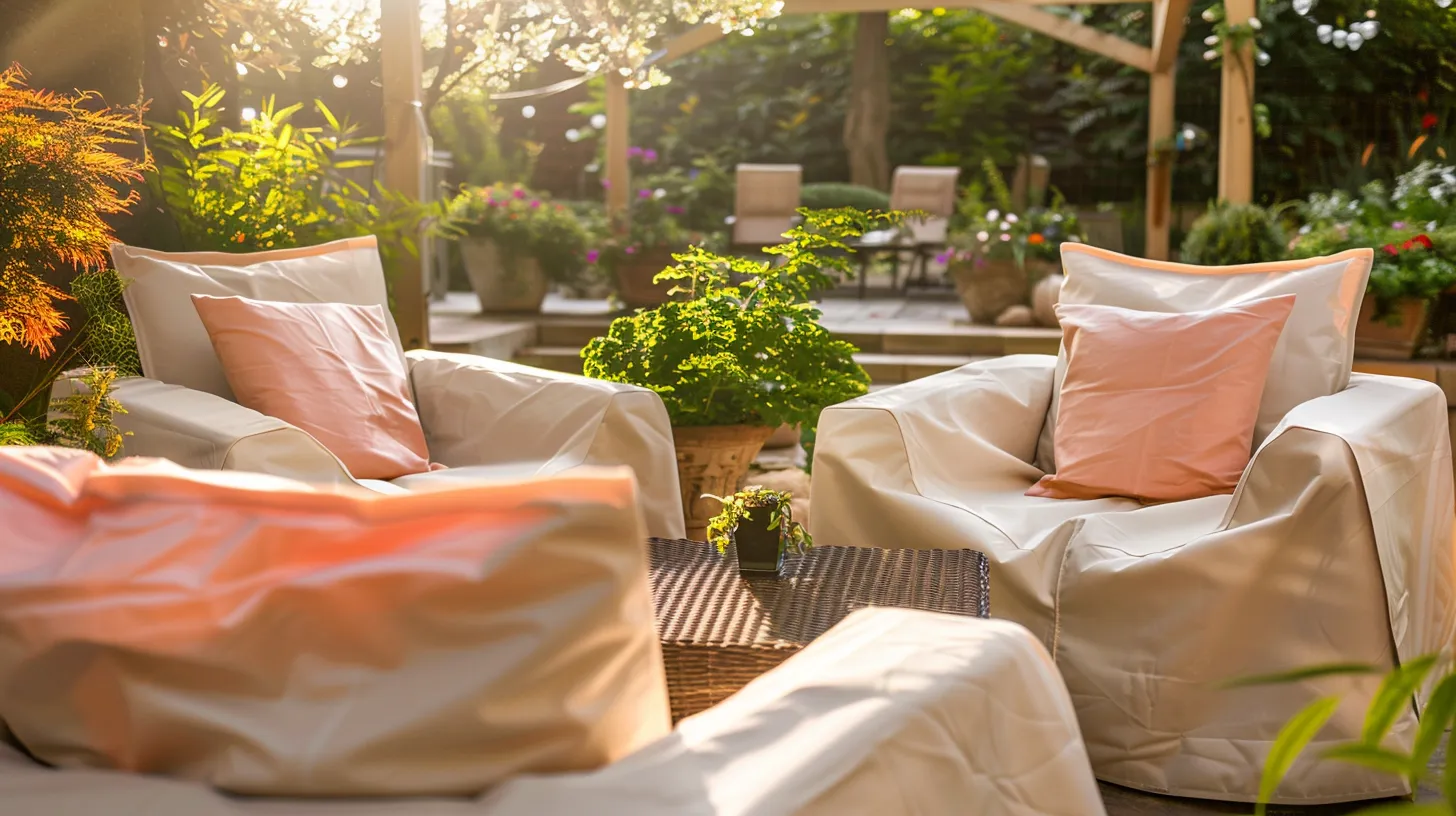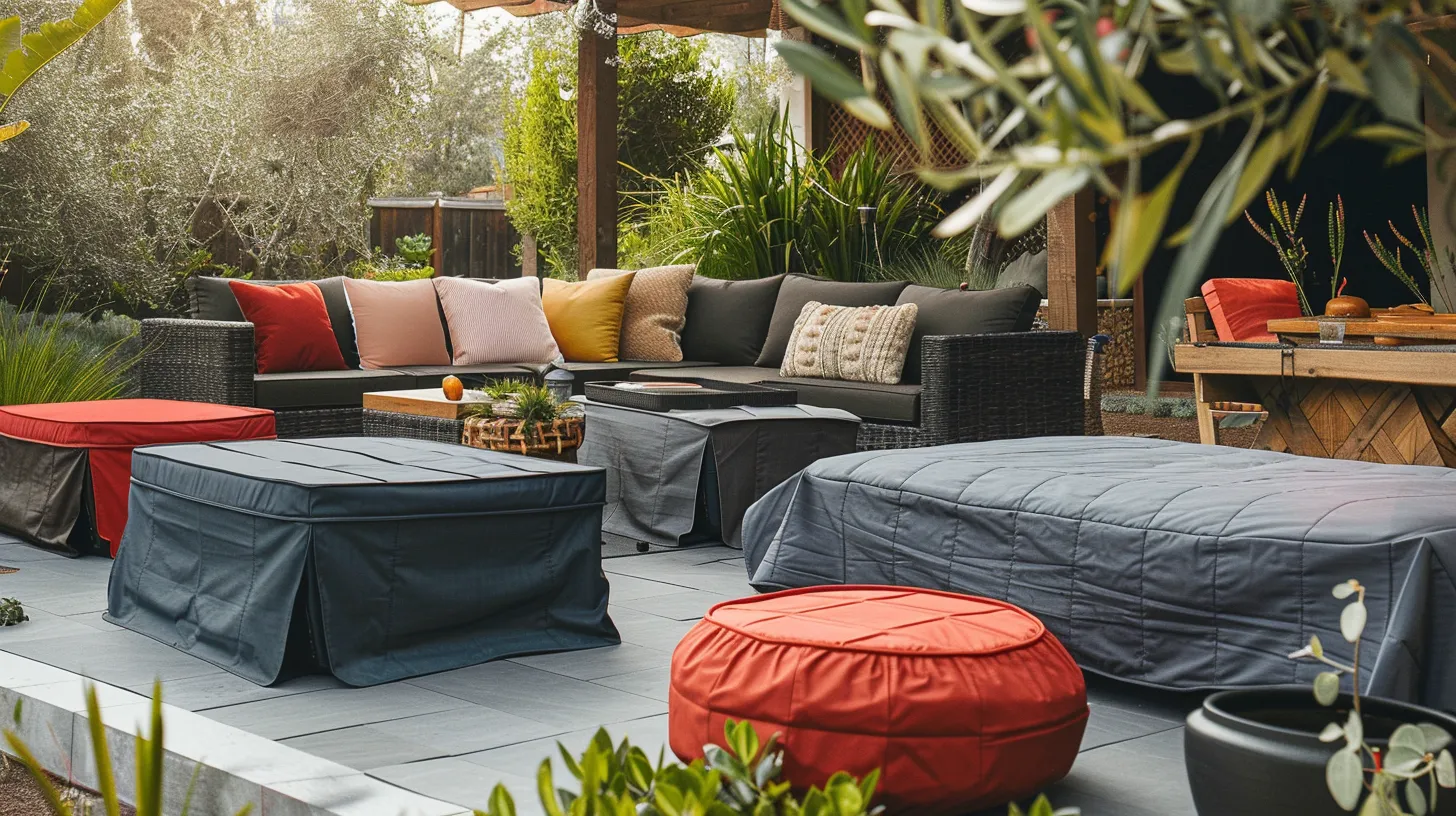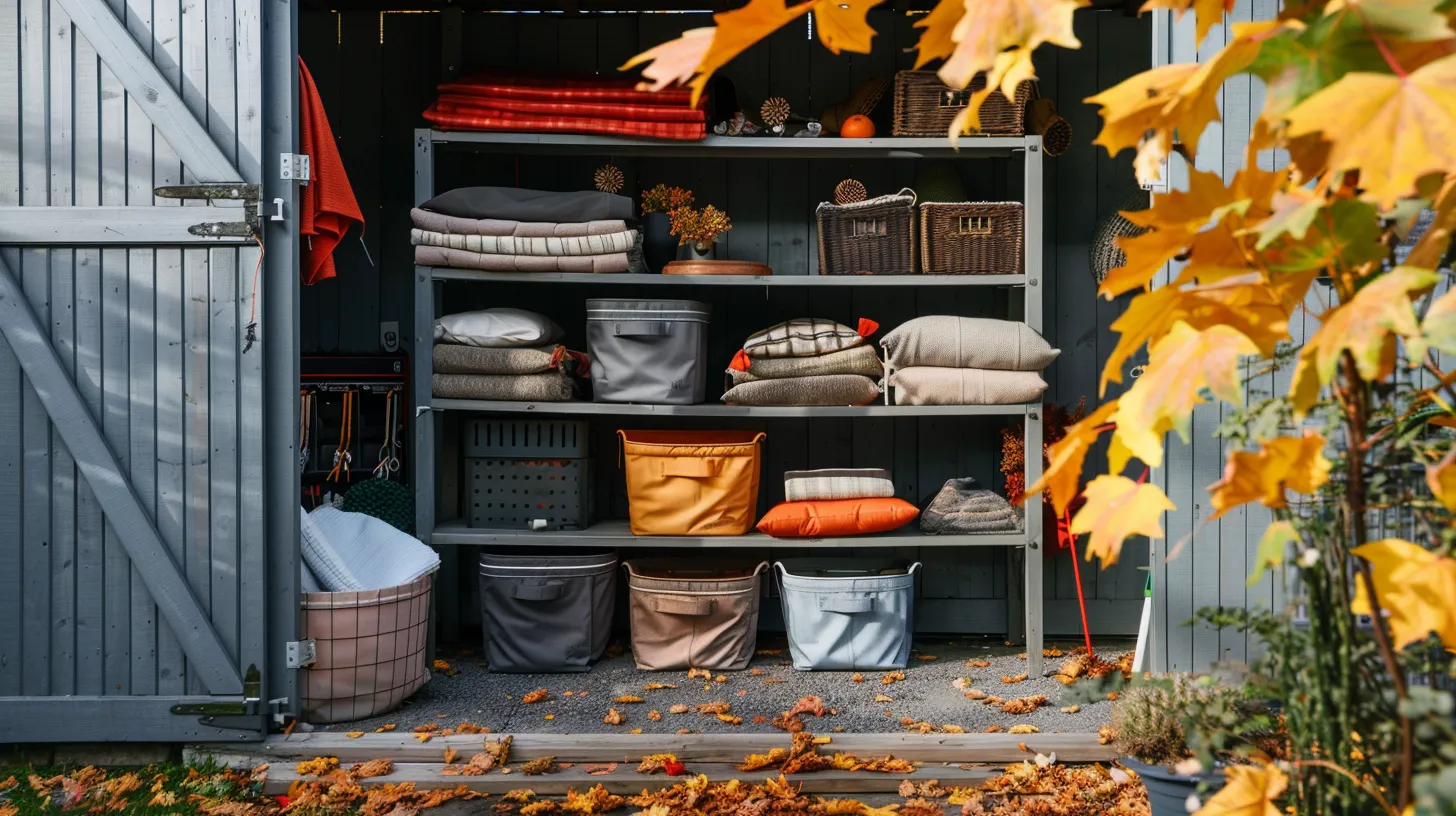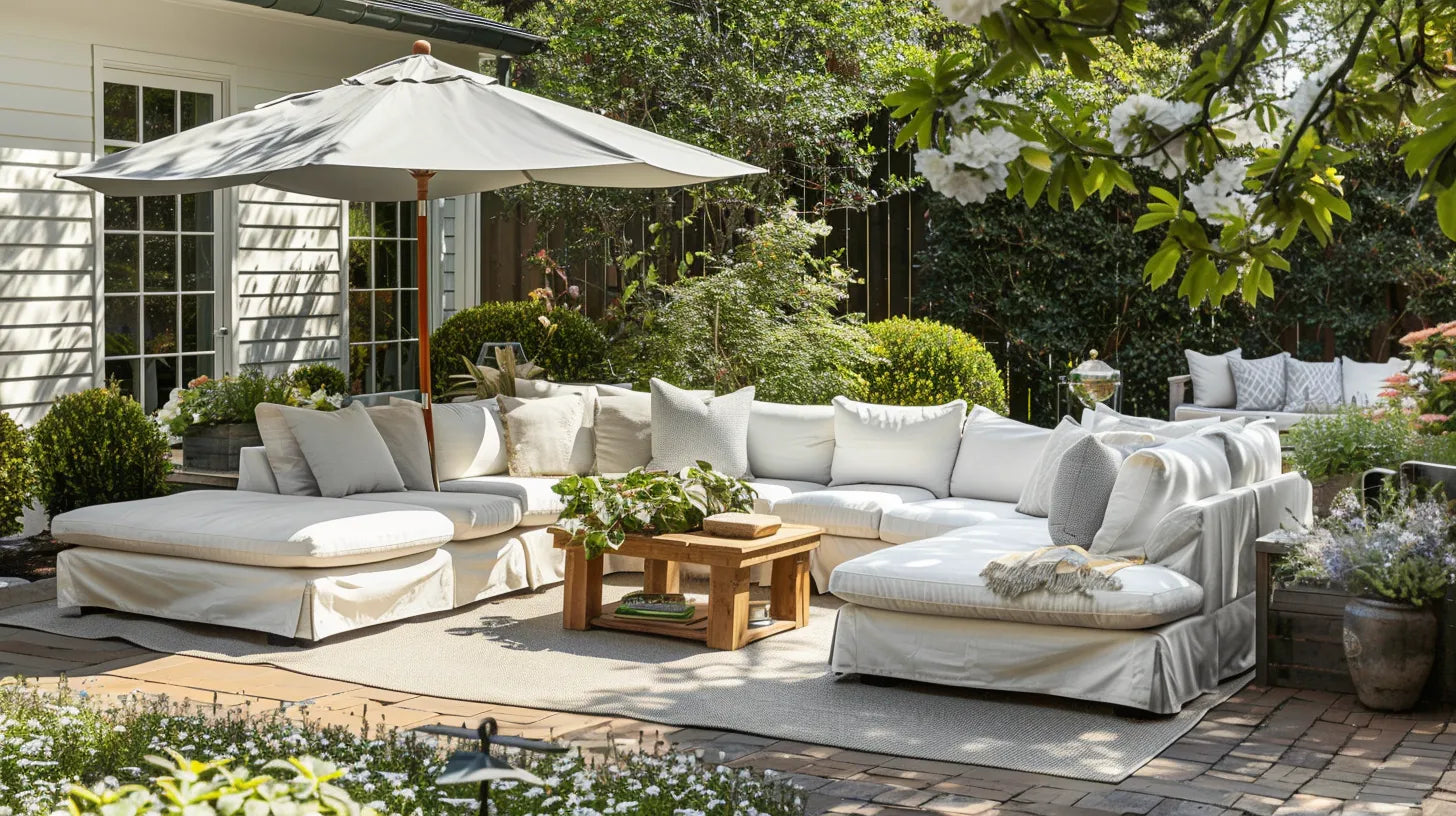Mastering the art of protection for outdoor patio furniture begins with selecting the right covers. Opt for materials like polyester or PVC-coated fabrics , which offer durability and resistance to UV rays and moisture. Guarantee covers fit snugly by measuring your furniture's dimensions accurately and allowing no more than 4 inches for best coverage. Features such as sturdy tie-downs enhance security in adverse weather, while regular maintenance , including cleaning with mild detergents and prompt repairs, extends the lifespan of the covers. Proper seasonal storage further protects and maintains the condition of the covers. Exploring these facets will guide you towards achieving longevity and style for your outdoor space.
Assessing Cover Materials

When selecting outdoor furniture covers , the choice of material is vital as it directly influences the level of protection against environmental factors such as UV rays , moisture , and dust . Material selection is not only about finding a functional fit; it also involves evaluating durability , weather resistance , and aesthetic appeal to make sure the covers enhance rather than detract from the outdoor space.
Among the popular materials are polyester , vinyl, canvas, acrylic, and PVC. Each offers a varying degree of water resistance and durability. For instance, polyester is favored for its lightweight and resistant properties against UV rays and moisture, making it a practical choice for furniture covers. Vinyl, while waterproof and durable, may not offer the same level of UV protection as specially treated materials.
PVC-coated fabrics stand out for their robustness and superior weather resistance. These materials are engineered to offer maximum protection from UV rays, preventing fading and extending the life of the furniture. When selecting covers, it is important to take into account these material characteristics to ensure excellent protection and maintenance of outdoor furniture's aesthetic and functional qualities.
Measuring for Perfect Fit

To guarantee a perfect fit for outdoor furniture covers , accurate measurements are essential, with a recommended allowance of no more than 4 inches to spare. Ensuring the longevity of your outdoor furniture hinges on this precision. ' Measure your furniture ' isn't just a recommendation—it's a necessity. Accurate dimensions help prevent water from pooling on the cover, which can degrade the material and damage the furniture beneath.
Commonly used methods involve measuring the height, width, and depth of each furniture piece. It's vital to make sure the cover does not touch the ground to allow for air circulation , further protecting against moisture and mold. A How to Measure Guide can provide invaluable tips and tricks for capturing these dimensions correctly, guaranteeing a snug fit that will effectively shield your furniture from the elements.
Oversized covers are a common pitfall. They may seem like a safe choice, but they can lead to water accumulation and potential damage during adverse weather conditions . To prevent water damage and ensure the cover serves its purpose, adhering to the precise measurements of your outdoor furniture is critical. This care in measurement not only preserves the functionality but also the aesthetic appeal of your outdoor spaces.
Features of Ideal Covers

After confirming your outdoor furniture covers are measured accurately, the next step is to consider the features that make these covers ideal for long-term protection and aesthetic appeal. Choosing outdoor patio furniture covers crafted from high-quality, weather-resistant materials such as PVC-coated fabrics is vital. These materials ensure maximum protection against various elements, preserving the furniture's look and structural integrity.
Tailored covers are especially important as they provide a snug fit that not only enhances furniture durability by preventing exposure to UV rays and rain but also minimizes the risk of wind damage. The precise fit helps in shielding the furniture from dust, debris, and other environmental pollutants, maintaining its pristine condition over time.
Additionally, premium covers equipped with sturdy tie-downs are essential for securing the covers in place, even during adverse weather conditions . This feature is pivotal in preventing the cover from blowing away and offering consistent protection against potential damage .
Maintenance Best Practices

Maintaining your outdoor patio furniture covers with regular cleaning and repairs is vital to preserve their condition and extend their lifespan. Implementing proper maintenance practices not only enhances protection but also guarantees longevity. To protect your furniture effectively, it's advisable to clean the covers regularly using a mild detergent and water solution . This gentle cleaning method helps maintain the freshness of the covers without compromising their integrity.
Furthermore, it is essential to avoid harsh chemicals that can degrade the fabric and cause premature wear. Instead, focus on substances that will not strip away essential waterproofing or UV-resistant coatings . Additionally, to prevent mold and mildew , it is beneficial to remove covers periodically. This action allows the furniture to breathe, reducing the risk of dampness-related damage.
Another key aspect of maintenance is to promptly address any small tears or loose seams . Taking immediate action to repair these issues prevents them from worsening, thereby maintaining the cover's ability to adequately protect your furniture. By adhering to these guidelines, you can greatly prolong the life of your patio furniture covers and ensure they continue to provide the necessary protection against environmental elements .
Seasonal Storage Strategies

As the seasons change , implementing effective storage strategies for patio furniture covers is important to guarantee their longevity and readiness for future use. Key to these seasonal storage strategies is ensuring that all covers are properly cleaned and dried before storage. This critical step helps prevent mold and mildew growth, common issues that can degrade the fabric over time.
Once the covers are clean and dry, using storage bags or containers can greatly protect covers while keeping them organized during the off-seasons. These containers shield the covers from dust, pests, and environmental damage. It's important to choose a storage location that is a cool and dry place , away from any direct sunlight or heat sources , to maintain the integrity of the covers.
Additionally, to avoid folding covers with sharp creases —which can lead to damage and unsightly wrinkles—consider using storage hooks or racks . These tools offer an effective way to hang the covers, allowing them to retain their shape and minimize required space. This method not only protects the covers but also helps to organize covers efficiently, making them easily accessible for when they are next needed.










